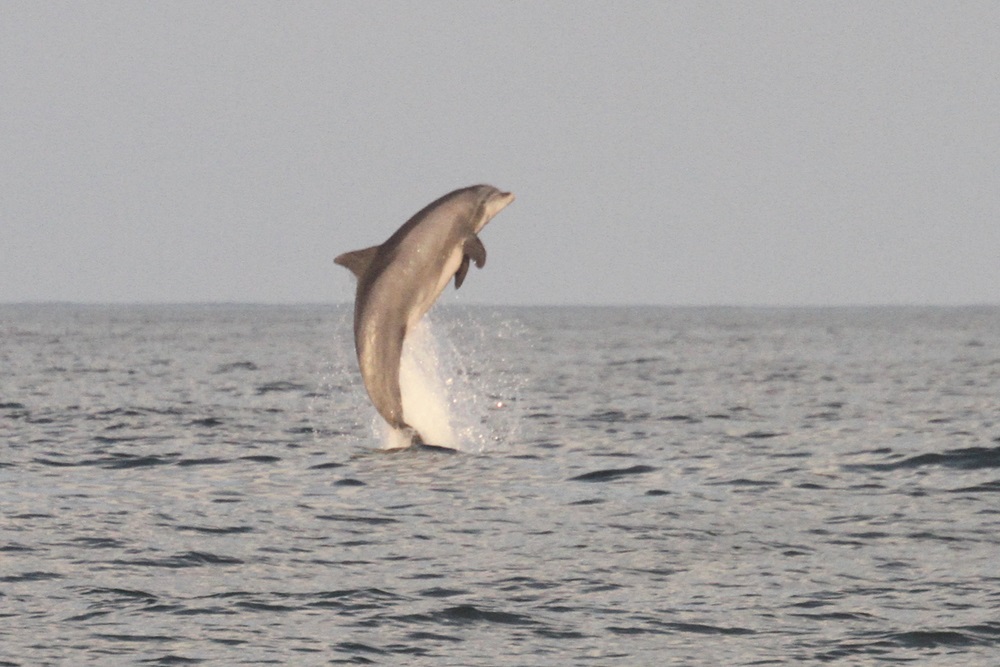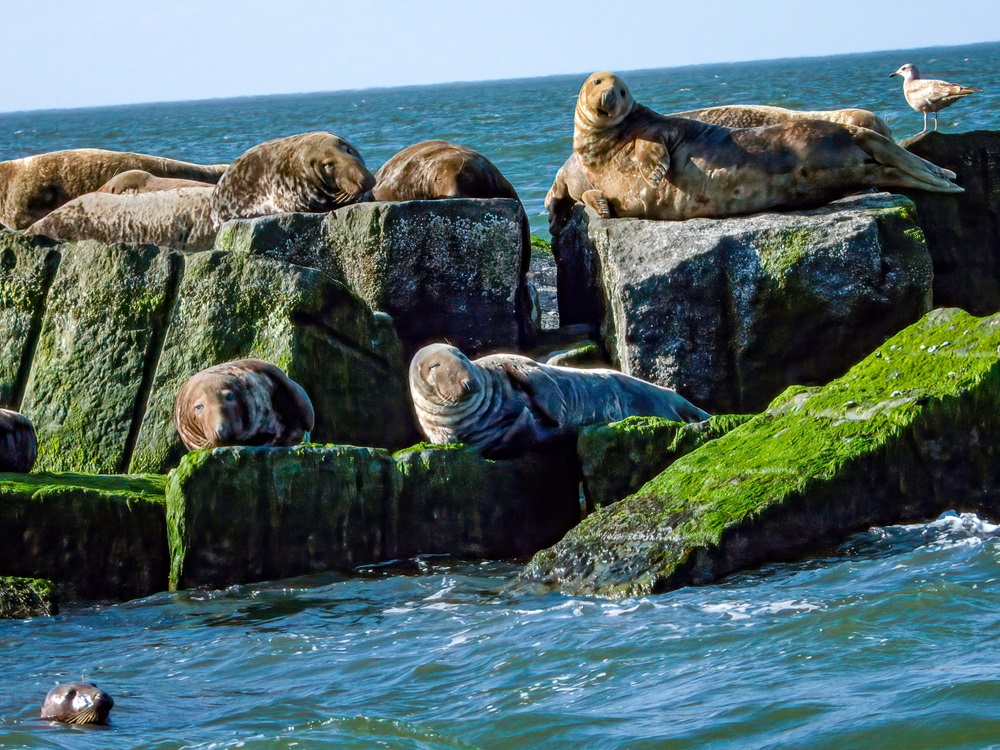Outdoor Delaware is the award-winning online magazine of the Delaware Department of Natural Resources and Environmental Control. Articles and multimedia content are produced by the DNREC Office of Communications.
Delaware’s beaches are some of the best in the country and arguably one of the most popular aspects of our state. Every year, millions of people come to the small wonder during the summer to spend a few hours, days, weeks or even months along the Delaware Bay, Inland Bays and Atlantic Ocean.
Visitors, especially those who return again and again, have the chance to witness a wide array of wildlife that might surprise even many Delawareans. In fact, for some, this wildlife is the main thing drawing them to the beaches.
To Chris Bennett, the environmental stewardship program manager within the Delaware Department of Natural Resources and Environmental Control’s Division of Parks and Recreation, perhaps the most interesting animal that can be found along Delaware’s beaches is the common bottlenose dolphin.

The highly intelligent aquatic mammal can be seen in Delaware as far north as Slaughter Beach, Bennett said. Dolphins often travel in pods made up of extended family members, consisting of about 15 to 30 members, and tend to visit the same places around the same time each day.
“Every once in a while, if there’s a big school of fish that they’re feeding on or for some reason they’re kind of feeling playful, you’ll see them actually jump clear out of the water, slap their tails on the surface, so you can see all kinds of interesting behaviors,” Bennett said.
If you’ve visited the beach enough, you’ve probably spotted dolphin fins offshore — a sight that is sure to stir up excitement about beachgoers.
Dolphins are most common during the summer but can be seen off Delaware from March to October. Only a few decades ago, the species usually wasn’t present here until May, but that has changed, likely due to climate change.
In contrast to dolphins, large whales are mostly seen farther offshore. Species like humpback, fin and minke whales typically are found in much deeper water, Bennett noted, though they are occasionally spotted from the beaches.
Two other animals sometimes seen from the beach vary greatly both in biology and in public opinion: seals and sharks. Seals are most common in the winter, having swam up to New England to mate by summertime, but it’s not unheard of for some to be spotted along the shore during the warmer months. Cape Henlopen State Park is known to be one of the best places in the state for fans hoping to see the pinnipeds.

While many people view seals as cute and cuddly, they should not approach them on land or in the water. After all, seals are still wild animals.
One animal that few people want to touch, in contrast, is the shark. Delaware’s waters are home to several kinds of sharks, including dogfish, sandbar sharks and sand tiger sharks, species that have been known to give birth in the Delaware Bay and come fairly close to shore, especially at night.
But that doesn’t mean you need to fear the toothy predators. Despite what “Jaws” might have you believe, shark attacks are exceedingly rare. According to the International Shark Attack File, there were just 36 unprovoked shark bites in the United States in 2023, with only two fatalities. There are no recorded deaths from shark attacks in Delaware ever.
Also found in the Delaware Bay is a species of fish known as the Atlantic sturgeon. Adult sturgeon spawn each spring and early summer in the Delaware River and then return to the saltwater of the bay and Atlantic Ocean where they spend the rest of the year. Sometimes viewed as a living fossil, they can be up to 15 feet long and 800 pounds, making sturgeon one of the largest fish species. Sturgeon have been known to breach like whales, seemingly throwing their entire bodies out of the water before they come crashing down again.
“If you’re looking in the right place at the right time, you’ll catch it and see it, because otherwise it happens so fast that it’s easy to miss,” Bennett said.
Another aquatic-dwelling animal that sometimes leaps above the waves is the ray, several species of which can be spotted around here. These include the cownose ray, which can be seen in the Inland Bays, especially by kayakers.
Speaking of kayaking, that’s a great way to spot marine life as long as you do so in water that’s no more than a few feet deep, enabling sunlight to reach to the ground beneath the waves. Snorkeling is also an option for those unafraid to dive under the water.
Other animals people might spot in the surf and sand include crabs, seahorses and the occasional squid or octopus. Additionally, tropical fish species like file, box and butterfly fish tend to get washed up into the Delaware Bay by the Gulf Stream in late summer, Bennett said.

Of course, we can’t forget Delaware’s official marine animal, the horseshoe crab. Despite the name, the species is actually more closely related to arachnids, a fact that’s sure to disturb at least one horseshoe crab-loving Delawarean.
Horseshoe crabs tend to stick to the Delaware Bay or the state’s Inland Bays because the waves from the ocean are usually too rough for them. The species spawns in May and June along the bay beaches. In fact, Delaware is home to the world’s largest horseshoe crab breeding ground, a display that draws visitors from many miles away every year.
The species, which has largely remained unchanged for more than 300 million years, has some special protections in state law, such as only allowing males to be harvested and even then setting a specific limit that cannot be exceeded. Horseshoe crabs exhibit sexual dimorphism, with females being noticeable larger than males.
There are roughly 30 million horseshoe crabs in the Delaware Bay, according to expert estimates.
Our state is also home to true crabs, such as the blue crab and the calico, also known as the lady, crab.
“If you’ve ever been to the beach in the summer and you’re walking along and you get pinched on your foot, that is most likely a lady crab,” Bennett said.
Meanwhile, mole crabs no more than 2 inches in size can be found burrowing in the sand along the water’s edge on beaches. If you’ve spotted little bubbles spouting from tiny holes in the sand after the waves recede, that’s likely a sign of mole crabs hiding beneath the sand. For generations, children playing at the beach have marveled at the tiny crustaceans, witnessing them bury themselves under the sand.
Jellyfish, chiefly members of the lion’s mane and stinging nettle variety, tend to show up in Delaware toward the end of the summer and are most often spotted after they’ve washed up on a beach and potentially been torn to pieces by predators or the elements.
Generally, there aren’t too many reptiles or amphibians people might encounter at a Delaware beach, but sea turtles have been known to venture north of Virginia from time to time. In 2018, 48 loggerhead sea turtles hatched at Fenwick Island State Park — the first such nesting here since 1973.
Birds of prey can be seen along the ocean and bay too. Ospreys and bald eagles, both of which catch and eat fish, are common along the coast. Ospreys snag fish by plunging feet-first into the water to capture their prey. Bald eagles often let the ospreys do the hard work and then attempt to steal their fish — an act of raptor-on-raptor crime.

Of course, gulls are ubiquitous, made all the more common by the many people who feed them while relaxing at the beach. This emboldens them to the point where they’ve even been known to fearlessly snatch food directly from peoples’ hands. Thus, Bennett recommends visitors to the Delaware beaches do not feed the gulls.
Beachgoers may also witness brown pelicans, a relatively new addition to the wildlife here.
One of the most surprising animals you might see at the beach is actually a pretty common species — it’s just rare to spot them along the bay or ocean. According to Bennett, deer occasionally turn up by the water’s edge.
River otters can very rarely be seen at the beach, though they prefer salt marshes, rivers and ponds.
The beaches are also popular with birdwatchers, who pay special attention to the great shorebird migration that grabs centerstage each spring.
“Delaware is most famous for the incredible shorebird migration that occurs each May, with species like red knot, ruddy turnstone, short-billed dowitchers, dunlin and others making their way through the Delaware Bay feeding on the superabundant supply of horseshoe crab eggs on their way up to their Arctic breeding grounds,” coastal waterbird biologist Katherine Christie with the DNREC Division of Fish and Wildlife said.
“As the summer progresses, we will start to see occasional individuals of those species on our beaches again as they make their way back down towards their wintering grounds. Some of these migrating species, like the sanderling, may be seen in Delaware throughout the year. Delaware supports breeding populations of American oystercatchers, least terns, and piping plovers, all of which create their shallow nest bowls right in the sand. Areas like the Point at Cape Henlopen State Park and Fowler Beach at Prime Hook National Wildlife Refuge are closed during the breeding season to create undisturbed breeding habitat for these vulnerable species.”
All this might make you want to hop in your car and drive to a beach along the shore, but there are some guidelines all visitors should follow, chiefly not interfering with wildlife. Delawareans and out-of-state guests are encouraged to watch wildlife but should remain at a distance from any animals, keeping in mind they are not pets.
Individuals with questions or concerns about animals they spot along the shore should contact DNREC.
If you’re looking for something to do this summer, why not visit one of Delaware’s award-winning beaches and observe the wildlife in the area? After all, as Bennett put it, “if you just pay attention to what’s going on around you, you never know what you’re going to see” at the beach.
Related Topics: animals, beach, birds, fish, horseshoe crabs, nature, outdoor delaware, sharks, summer